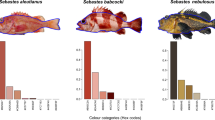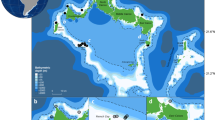Abstract
Of the approximately 1.5 million species described to date, about 48 170 (3.2%) are vertebrates. Of these 24 618 (51%) are fishes. Amazingly, 41% of fishes are found in fresh water which makes up a negligible percentage of the water on earth. The sea accounts for 97% of all water on the planet and contains 58% of the fish species, mostly from shallow, warm-coastal areas. The families Cichlidae, Cyprinidae, Characidae, Loricariidae, and Cyprinodontidae constitute about half of all the recently described new freshwater fish species named in the period 1978–1993. The Gobiidae and Serranidae are the marine families with the largest number of recently described new species. The most new freshwater teleost names came from South America (39%), Africa (32%) and Asia (17%). New fish species continue to be described at the rate of roughly 130–160 each year. An estimated 13 775 new fish names have been proposed in this century, representing about 56% of all currently known fish species. Three species are discussed in detail to represent remarkable examples of 20th century fish discoveries: the coelacanth Latimeria chalumnae, the salamanderfish Lepidogalaxias salamandroides of Western Australia, and the megamouth shark Megachasma pelagios.
Similar content being viewed by others
References cited
Allen, G.R. & T.M. Berra. 1989. Life history aspects of the west Australian salamanderfish, Lepidogalaxias salamandroides. Mees. Rec. West. Austr. Mus. 14: 253–267.
Balon, E.K. 1990a. The living coelacanth endangered: a personalized tale. Tropical Fish Hobbyist 38 (February): 117–129.
Balon, E.K. 1990b. Tracking the coelacanth: a follow-up tale. Tropical Fish Hobbyist 38 (March): 122–131.
Balon, E.K. 1991a. Prelude: the mystery of a persistent life form. Env. Biol. Fish. 32: 9–13.
Balon, E.K. 1991b. Probable evolution of the coelacanth's reproductive style: lecithotrophy and orally feeding embryos in cichlid fishes and in Latimeria chalumnae. Env. Biol. Fish. 32: 249–265.
Balon, E.K., M.N. Bruton & H. Fricke. 1988. A fiftieth anniversary reflection on the living coelacanth, Latimera chalumnae: some new interpretations of its natural history and conservation status. Env. Biol. Fish. 23: 241–280.
Berra, T. M. 1981. An atlas of distribution of the freshwater fish families of the world. University of Nebraska Press, Lincoln. 197 pp.
Berra, T.M. 1991. Population structure and development of Lepidogalaxias salamandroides (Pisces: Salmoniformes) from Western Australia. Copeia 1991: 845–850.
Berra, T.M. & G.R. Allen. 1989. Burrowing, emergence, behavior, and functional morphology of the Australian salamander-fish, Lepidogalaxias salamandroides. Fisheries 14(5): 2–10.
Berra, T.M. & G.R. Allen. 1995. Inability of salamanderfish, Lepidogalaxias salamandroides, to tolerate hypoxic water. Rec. West. Austr. Mus. 17: 117.
Berra, T.M. & R.M. Berra. 1977. A temporal and geographical analysis of new teleost names proposed at 25 year intervals from 1869–1970. Copeia 1977: 640–647.
Berra, T.M. & J.B. Hutchins. 1990. A specimen of megamouth shark, Megachasma pelagios (Megachasmidae) from Western Australia. Rec. West. Austr. Mus. 14: 651–656.
Berra, T.M. & J.B. Hutchins. 1991. Natural history notes on the megamouth shark, Megachasma pelagios, from Western Australia. West. Austr. Nat. 18: 224–233.
Berra, T.M., D.M. Sever & G.R. Allen. 1989. Gross and histological morphology of the swimbladder and lack of accessory respiratory structures in Lepidogalaxias salamandroides, an aestivating fish from Western Australia. Copeia 1989: 850–856.
Boyes, K. & C. Stepien. 1995. Relationships of the rare deep sea shark megamouth to other sharks: DNA evidence. Ohio J. Sci. 95: 15.
Bruton, M.N. 1995. Threatened fishes of the world: Latimeria chalumnae Smith, 1939 (Latimeriidae). Env. Biol. Fish. 43: 104.
Bruton, M.N., A.J.P. Cabral & H. Fricke. 1992. First capture of a coelacanth, Latimeria chalumnae (Pisces, Latimeriidae), off Mozambique. S. Afr. J. Sci. 88: 225–227.
Bruton, M.N. & S.E. Coutouvidis. 1991. An inventory of all known specimens of the coelacanth Latimeria chalumnae, with comments on trends in the catches. Env. Biol. Fish. 32: 371–390.
Bruton, M.N., S.E. Coutouvidis & J. Pote. 1991. Bibliography of the living coelacanth Latimeria chalumnae, with comments on publication trends. Env. Biol. Fish. 32: 403–433.
Clark, E. & J. Castro. 1995. ‘Megamama’ is a virgin: dissection of the first female specimen of Megachasma pelagios. Env. Biol. Fish. 43: 329–332.
Cloutier, R. 1991. Patterns, trends, and rates of evolution within the Actinistia. Env. Biol. Fish. 32: 23–58.
Cohen, D.M. 1970. How many recent fishes are there? Proc. Cal. Acad. Sci. 38: 341–346.
Compagno, L.J.V. 1990. Relationships of the megamouth shark, Megachasma pelagios (Lamniformes: Megachasmidae) with comments on its feeding habits. pp. 357–379. In: H.L. Pratt Jr., S.H. Gruber & T. Taniuchi (ed.) Elasmobranchs as Living Resources: Advances in the Biology, Ecology, Systematics, and the Status of the Fisheries, NOAA Technical Report NMFS 90.
Forey, P. 1984. The coelacanth as a living fossil. pp. 166–169. In: N. Eldredge & S.M. Stanley (ed.) Living Fossils, Springer Verlag, New York.
Forey, P.L. 1988. Golden jubilee for the coelacanth Latimeria chalumnae. Nature 336: 727–732.
Forey, P.L. 1991. Latimeria chalumnae and its pedigree. Env. Biol. Fish. 32: 75–97.
Fricke, H., K. Hissman, J. Schauer, O. Reinicke, L. Kasang & R. Plante. 1991. Habitat and population size of the coelacanth Latimeria chalumnae. Env. Biol. Fish. 32: 287–300.
Fricke, H., O. Reinicke, H. Hofer & W. Nachtigall. 1987. Locomotion of the coelacanth Latimeria chalumnae in its natural environment. Nature 329: 331–333.
Funch, P. & R.M. Kristensen. 1995. Cycliophora is a new phylum with affinities to Entoprocta and Ectoprocta. Nature 378: 711–714.
Greenwell, J.R. 1990. The lady and the coelacanth: remembering the zoological discovery of the century. The Explorers Journal 68: 117–123.
Groombridge, B. (ed.) 1992. Global biodiversity: status of the earth's living resources. Chapman and Hall, London. 585 pp.
Heemstra, P.C. & A.L.J. Freeman. 1996. First authentic capture of a coelacanth, Latimeria chalumnae (Pisces: Latimeriidae), off Madagascar. S. Afr. J. Sci. 92: 150–151.
Heuvelmans, B. 1983. How many animal species remain to be discovered? Cryptozoology 2: 1–24.
Horn, M. 1972. The amount of space available for marine and freshwater fishes. U.S. Fish. Bull. 70: 1295–97.
Jarvik, E. 1980. Basic structure and evolution of vertebrates. Vol. 1. Academic Press, New York. 575 pp.
Johnson, G.D. & C. Patterson. 1996. Relationships of lower euteleostean fishes. pp. 251–332. In: M. L. J. Stiassny, L. R. Parenti & G.D. Johnson (ed.) Interrelationships of Fishes, Academic Press, San Diego.
Lagios, M.D. 1979. The coelacanth and the chondrichthyes as sister groups: a review of shared apomorphic characters and a cladistic analysis and reinterpretation. Occ. Papers Cal. Acad. Sci. 134: 25–44.
Lavenberg, R.J. 1991. Megamania: the continuing saga of megamouth sharks. Terra 30(1): 30–39.
Lavenberg, R.J. & J.A. Seigel. 1985. The Pacific's megamystery-megamouth. Terra 23(4): 30–31.
Maisey, J.G. 1985. Relationships of the megamouth shark, Megachasma. Copeia 1985: 228–231.
Margulis, L. & K.V. Schwartz. 1982. Five kingdoms. Freeman & Co., San Francisco. 338 pp.
Martin, K.L.M., T.M. Berra & G.R. Allen. 1993. Cutaneous aerial respiration during forced emergence in the Australian salamanderfish, Lepidogalaxias salamandroides. Copeia 1993: 875–879.
May, R.M. 1992. How many species inhabit the earth? Sci. Amer. 267(4): 42–48.
McCain, K.W. 1994. Islands in the stream: mapping the fisheries and aquatic sciences literatures. Fisheries 19(10): 20–27.
McCosker, J.E. 1979. Inferred natural history of the living coelacanth, Latimeria chalumnae. Occ. Pap. Cal. Acad. Sci. 134:17–24.
McCosker, J.E. & M.D. Lagios (ed.) 1979. The biology and physiology of the living coelacanth. Occ. Pap. Cal. Acad. Sci. 134: 1–175.
McDowall, R.M. 1988. Diadromy in fishes. Croom Helm, London. 308 pp.
Mees, G.F. 1961. Description of a new fish of the family Galaxiidae from Western Australia. J. Royal Soc. West. Austr. 44: 33–38.
Meyer, A. 1995. Molecular evidence on the origin of tetrapods and the relationships of the coelacanth. Trends in Ecology and Evolution 10: 111–116.
Mishler, B.D. & M.J. Donoghue. 1982. Species concepts: a case for pluralism. Syst. Zool. 31: 491–503.
Miya, M., M. Hirosawa & K. Mochizuki. 1992. Occurrence of a megachasmid shark in Suruga Bay: photographic evidence. J. Nat. Hist. Mus. & Inst., Chiba 2: 41–44.
Musick, J.A., M.N. Bruton & E.K. Balon (ed.) 1991. The biology of Latimeria chalumnae and the evolution of coelacanths. Env. Biol. Fish. 32: 1–438 (also as Developments in Env. Biol. Fish. 12, Kluwer Academic Publishers, Dordrecht).
Myers, G.S. 1938. Fresh-water fishes and West Indian zoogeography. Ann. Rep. Smithsonian Inst. for 1937: 339–364.
Myers, G.S. 1949. Salt-tolerance of fresh-water fish groups in relation to zoogeographical problems. Bijdragen tot de Dierkunde 28: 315–322.
Myers, G.S. 1951. Freshwater fishes and East Indian zoogeography. Stanford Ichthyol. Bull. 4(1): 11–21.
Nakaya, K. 1989. Discovery of a megamouth shark from Japan. Japan. J. Ichthyol. 36: 144–147 (in Japanese).
Nelson, D.R., J.N. McKibben, W.R. Strong, Jr., C.G. Lowe, J.A. Sisneros, D.M. Schroeder & R.J. Lavenberg. 1997. An acoustic tracking of a megamouth shark, Megachasma pelagios: a crepuscular vertical migrator. Env. Biol. Fish. 49: 389–399.
Nelson, J.S. 1994. Fishes of the world, 3rd ed. John Wiley, New York. 600 pp.
Patterson, C. & G.D. Johnson. 1995. The intermuscular bones and ligaments of teleostean fishes. Smithsonian Contri. Biol. 559: 1–85.
Pimm, S.L., G.J. Russell, J.L. Gittleman & T.M. Brooks. 1995. The future of biodiversity. Science 269: 347–50.
Pussey, B.J. 1986. The effect of starvation on oxygen consumption and nitrogen excretion in Lepidogalaxias salamandroides (Mees). J. Comp. Physiol. 156B: 701–705.
Pussey, B.J. 1989. Aestivation in the teleost fish Lepidogalaxias salamandroides (Mees). Comp. Biochem. Physiol. 92A: 137–138.
Pusey, B.J. 1990. Seasonality, aestivation and the life history of the salamanderfish Lepidogalaxias salamandroides (Pisces: Lepidogalaxiidae). Env. Biol. Fish. 29: 15–26.
Pusey, B.J. & T. Stewart. 1989. Internal fertilization in Lepidogalaxias salamandroides Mees (Pisces: Lepidogalaxiidae). Zool. J. Linn. Soc. 97: 69–79.
Schultze, H.-P. 1994. Comparison of hypotheses on the relationships of sarcopterygians. Syst. Zool. 43: 155–73.
Séret, B. 1995. Première capture d'un requin grande gueule (Chondrichthyes, Megachasmidae) dans L'Atlantique, au Large du Sénégal. Cybium 19: 425–427.
Smith, J.L.B. 1939. A living fish of Mesozoic type. Nature 143: 455.
Smith, J.L.B. 1956. Old fourlegs. The story of the coelacanth. Longmans, London. 260 pp.
Takada, K. 1994. Stranding of a megamouth shark in Hakata-Bay. Rep. Japan. Soc. Elasmobranch Studies 31:13–16 (in Japanese).
Taylor, L.R., L.J.V. Compagno & P.J. Struhsaker. 1983. Megamouth-a new species, genus, and family of lamnoid shark (Megachasma pelagios, family Megachasmidae) from the Hawaiian Islands. Proc. Cal. Acad. Sci. 43A: 87–110.
Templeton, A.R. 1989. The meaning of species and speciation: a genetic perspective. pp. 3–27. In: D. Otte & J. A. Endler (ed.) Speciation and Its Consequences, Sinauer Associates, Sunderland.
Thompson, K.S. 1991. Living fossil: the story of the coelacanth. W.W. Norton, New York. 252 pp.
Uyeno, T. & T. Tsutsumi. 1991. Stomach contents of Latimeria chalumnae and further notes on its feeding habits. Env. Biol. Fish. 32: 275–279.
Waters, J.M. 1996. Aspects of phylogeny, biogeography and taxonomy of galaxoid fishes. Ph.D. Thesis, University of Tasmania, Hobart. 159 pp.
Wilson, E.O. 1992. The diversity of life. Harvard University Press, Cambridge. 424 pp.
Wourms, J.P., J.W. Atz & M.D. Stribling. 1991. Viviparity and maternal-embryonic relationship in the coelacanth Latimeria chalumnae. Env. Biol. Fish. 32: 225–248.
Author information
Authors and Affiliations
Rights and permissions
About this article
Cite this article
Berra, T.M. Some 20th century fish discoveries. Environmental Biology of Fishes 50, 1–12 (1997). https://doi.org/10.1023/A:1007354702142
Issue Date:
DOI: https://doi.org/10.1023/A:1007354702142




